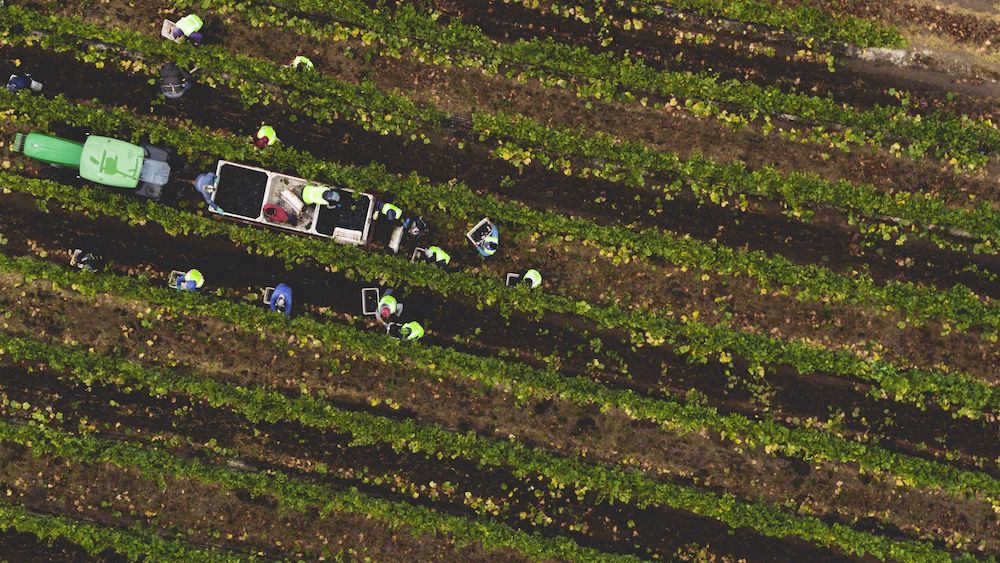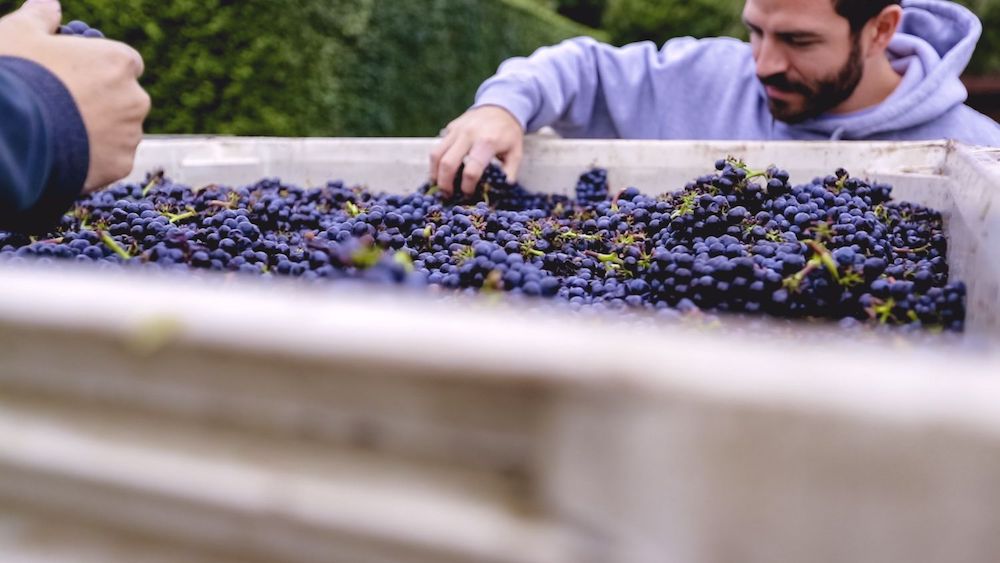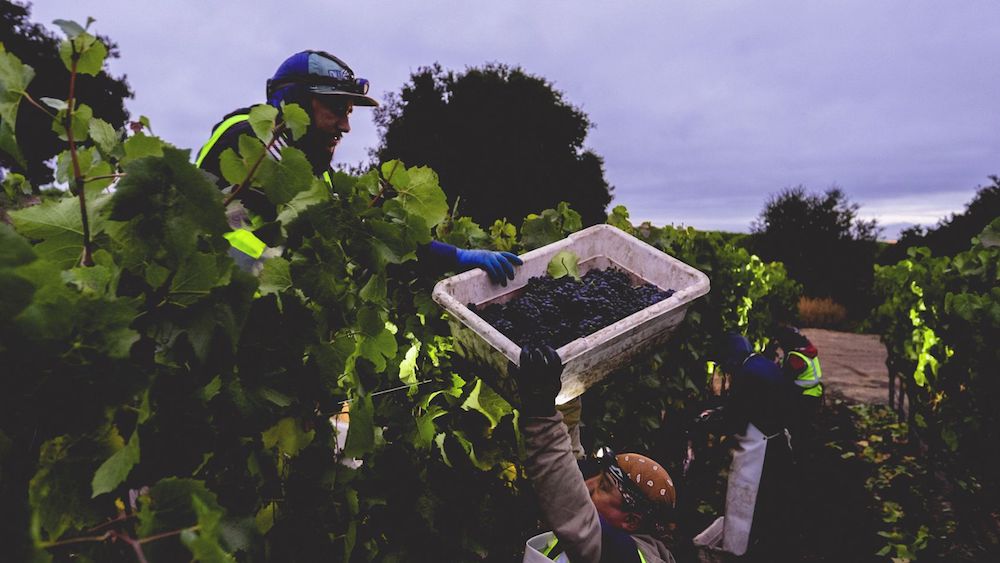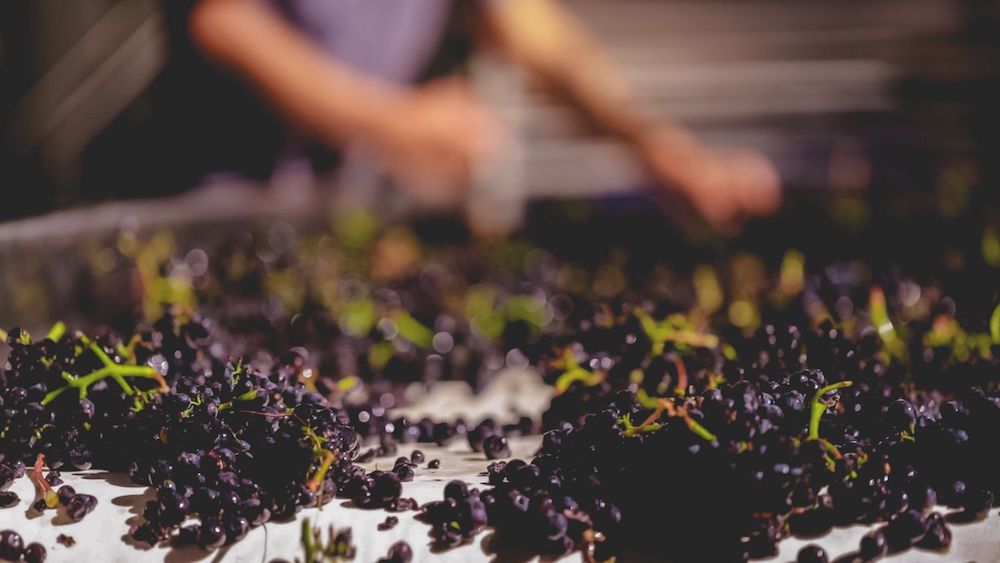
September 19, 2023 – The winegrowers of the Santa Lucia Highlands have not been sitting around twiddling their thumbs while they wait for Mother Nature to turn up the thermostat to the Summer setting. They’ve been busy dropping green clusters, some for the second time, in an attempt to push the grapes to ripeness.
In a Harvest Update Zoom call, organized and moderated by SLH Artisans Executive Director Gwen McGill, we heard from Scott Caraccioli of Caraccioli Cellars, Adam Lee of Clarice Wine Company, Annie Lee of Morgan, Michelle Shafrir of Miner and Gary Franscioni of ROAR, all of whom echoed their appreciation for the beneficial rains of the winter, and the fairly abundant crop it had brought forth. It just hasn’t been brought forth to ripeness with any alacrity quite yet.
Franscioni reports a total of 22.5” of rain for the 2022/2023 winter season, which is the most he’s recorded since 1983/84 and 1998/99. They typically receive 10” to 14” in a good year. He reported that all the water was on the valley floor and caused no damage to his hillside vines. Budbreak this year occurred in mid-April, whereas it usually happens by March 8 or 10. He also reported rain in June and exceptionally cool weather all summer. One upside is they did not have to water at all this year.
Annie Lee of Morgan said the biggest impact of all that precipitation was huge vigor in the vines and the cover crop, which was waist high. “Bud break was a month late at Double L. It’s usually late March or early April. We started flowering in early June and we had good fruit set: we’re really happy!”
Fortunately, she knew from the time of budbreak in April that she had her work cut out for her in the vineyard. “I knew a lot of vineyard work would need to be done during May and June.”
Franscioni concurs on the vigor issue saying he has heavy cluster weights and the labor bills for canopy management have been way up. “Adam Lee had a good idea to leave suckers down below on the trunk to draw vigor away from the canopy,” says Franscioni. “So we tried that.”

However, those making sparkling wines have been busy picking.
Scott Caraccioli reports that they had 21” of rain at Escolle Vineyard compared to the usual 13 inches. “Overall set has been solid, but you don’t know the cluster weights until you approach ripeness. The clusters definitely continue to gain weight and the extra water in soil and canopy is pushing ripeness because we are so far behind. We were 25 to 27 days behind for sparkling and everything else, too. But this is such a benefit for phenolic ripeness and complexity. The sugar accumulation benefited from extra days of hangtime.”
He says picking for sparking began August 29, which was 25 days later than in 2021. They did not harvest much in 2022. He reports that brix levels have been very close from block to block and the acid retention is awesome. In fact, he has lots that are 12.5 and 13 acid (TA). “We have a hard time predicting the brix levels: the change from day to day has been very slow,” says Caraccioli. “Sparkling is one of those things when there is that ‘right day’ to pick, even more so than still wine!”
What about yields? “It’s average yields, based on my sample set of 35% of the vineyard,” says Caraccioli. “There are small yielding clones that are up 15% and large yielding ones that are 25% less, while some are 20% more. It’s location dependent. Where the fog sits is very obvious, as it plays into overall set and moisture. I haven’t irrigated anything this vintage. The vines have so much horsepower in the soil.”
Sabrine Rodems also harvested some Chardonnay from the San Saba Vineyard for her Wrath and Scratch sparkling programs on September 13.
It’s clear that harvest is in slow motion mode: Franscioni says that veraison started exactly one month later than usual, on August 7, and as a result, everything is tracking 4 weeks behind. He says he sees a notable difference in the vineyards at the southernmost and northernmost poles of the SLH. “The south usually ripens earlier, but the north is way ahead this year,” notes Franscioni. “We did not have the usual inversion layer this year until early August. Usually, it is cooler down south during the winter, and then the south catches up to the north in the summer.” This is due to the moderating impact of the Monterey Bay which is strongest in the middle to northern part of the SLH bench, and falls off significantly to the south, which is farther removed from the ocean’s impact.

Annie Lee noted there’s a little bit of green fruit still left at Double L. “We went through and thinned green fruit to help the rest of the fruit ripen. We have a lower field and an upper field, and usually the upper field is a few days ahead of everything. This year it is switched, which is unusual.” She says there is so much fruit, they’ll be doing a second pass to thin this week.
Winemaker Adam Lee (Siduri, Clarice) has been making wine from SLH vineyards for almost two decades. “From a winemaking point of view, we are going to be sampling a lot of everything this year!” says Lee. “Usually, we think we know what comes in first, but not necessarily this year!” He pointed out that the ground being cool and refusing to warm up for so long, along with no major heat spikes, has kept things in stasis. Recently, the overnight lows have been higher, which helps move things along. “The higher highs don’t matter as much during the day as the overnight high lows! This is what is helping us a lot now.”
He pointed out that Oregon is picking for both sparkling and still wines right now, and they are at 23 and 25 Brix now for Pinot Noir.
Michelle Shafrir at Miner in Napa says that they waiting on Rosellas, Garys and Sierra Mar Vineyards, which will all come in about when their Carneros Chardonnay will be coming in. She mentioned that with the colder winter and spring, and later budbreak and bloom, they are also at least a month behind, but she has been at this long enough to keep it in perspective. “We were so far ahead last year, so this feels really behind! I remember 2011 being much later and the old timers are talking about how this reminds them of 1998 and 1994.”
She pointed out that in Napa, the vineyards at 1,000 feet elevation and higher are later to get to veraison and taking longer to ripen. “I am hoping we can retain acidity better this year than last! We have less sugar accumulation, so we can take our time.” She says she’s looking forward to do very little in the cellar. “The biggest challenge is mold and botrytis pressure, but the farmers are keeping up with it in the SLH. We do wild yeast ferments, and we don’t have to add water or tartaric, so I am expecting beautiful wines, with no manipulation needed. I am just going to watch!!”
Adam Lee remarked that 1999 was his all-time favorite vintage, while 2011 was his most challenging, as it was a cool year with rain in early October. He expects to get Pinot Noir clone 777 from Rosella’s first – which is typical.
Gary Franscioni pointed out that there are 3,600 acres of Pinot Noir in the SLH out of 6,000 acres planted. “These are actually classic growing conditions for Pinot Noir. It’s ideal to have all the development time in September with less chance of extreme heat waves in October.”
He feels 2023 can be the best ever if it’s a dry October, and if we can get Indian Summer, although he admits that is asking too much! “On Oct 1, 1999, we started harvest, and we had Indian summer, with temps up to 80 during the day, and we got it done within 3 weeks.” One can dream.

Annie Lee concurs that hang time is everything, and said that the cooler and steady summer weather allows them to pick and choose when they harvest. “Since we do it all by hand, if we have a hot couple of weeks, it makes it harder. So far, so good, as we can make the best decisions. We harvest one clone at a time, so we can be monitoring them and pick them at their peak.”
Caraccioli had originally planned to begin picking Pinot Noir this week, beginning with 943, and then clone 115, but that looks to be delayed. “We have some stuff at 22, and most everything is at 20. Chard is behind at 18 or so, so it could be 3 to 4 weeks before we start harvesting that.”
Adam Lee is at a custom crush facility and confesses his biggest worry is running out of tank space, as everyone will be bringing in Napa Cab right on the heels of Pinot Noir from the SLH. One thing he’s noticing is lignification at Rosella’s: the dark and woody shoots indicate that the vines are not growing canopy any longer and are not putting a lot into the fruit. This leads to brown seeds, which means he plans to do a lot of whole cluster this year. “We might have good acids, and this can help mitigate that,” says Lee. “We can also see less fruit and color concentration with lower alcohols and we might have a low alcohol year. I might do more cold soak and more skin contact.” And that will mean more time in tank, which will increase the competition for space with his winemaking peers.
Gary Franscioni says he saw lignification even before veraison, as did Annie Lee, and Scott Caraccioli noted that he saw brown stems at 15 brix: everything is going brown.
Then it was time to talk Chardonnay. Annie Lee of Morgan said that the Double L Chard tastes really good. “I am in the vineyard and am eating grapes all day long and forget to eat lunch!” She admits the mildew pressure was really hard as they are certified organic, so mitigating it is very labor intensive, involving hedging and de-leafing. “It’s a labor of love, but the hours we spend on the mower and de-leafer results in high quality grapes on the back side.”
Caraccioli said he believes Chardonnay is going to be picked more on pH levels than Brix, as it is so far behind. “We will lose acid as we gain sugar.”
Gary Franscioni appeared to be the contrarian. “My Chard is running ahead of my Pinot!! I don’t know what is going on! October 5 to October 20 is going to be crazy – a very short window – we are going to see Chard in before Pinot Noir finishes up.”
And let’s not forget Syrah, of which there are only 60 acres in the SLH. It’s looking to be a longshot to ripen this varietal in Escolle and Double L this year, although Scott thinks November is possible, and will be making a second pass to balance the fruit load with the canopy.
Gary Franscioni refers to Syrah here as a cool climate grape and in 2002, his Rosella’s Syrah came in November 7 and November 10, so this year might beat that. He went to 18 clusters per vine in September, just to give the grapes a shot at being ready before the end of November.
Said Franscioni in closing out the session, “The hardest part about harvest is waiting.”
Elsewhere In California
In Napa, the Sauv Blanc is coming in and is all picked at Gamble Family Vineyard where I visited last week. Winemakers, including Julien Fayard, who pull from multiple vineyards, said they will be finished picking SB in Napa and Sonoma by the end of this week.
The Cab in Napa is looking four weeks out. It usually starts coming in by mid-October.
In the Anderson Valley, they were well underway with harvesting of Sauvignon Blanc and Chardonnay in early September, and were getting ready to bring in Muscat, Gewurztraminer, Pinot Noir, Chenin Blanc and Zinfandel. Cabernet Sauvignon is usually the last to ripen in early October. Anderson Valley is pretty much on track because it’s always cool and wet in the spring, so their year is pretty normal. They actually had more heat up north.
Up in El Dorado in the northern Sierra Foothills, Chef Brian Overhauser (who was formerly Chef at Hahn), says his winery, Element 79, has picked Viognier for a hopped sparkling, which will go into cans. Other wineries in the region had also picked Viognier. One of the growers there, Tom Sinton of Starfield, noted that for the first time in memory, the red varieties had finished veraison before the whites. His theory is that because the white varietals were affected by frost in 2022, “they may have suffered some tissue damage in the cordons, which set their development back a couple of weeks this spring.”
About the author
Laura Ness is a longtime wine journalist, columnist and judge who contributes regularly to Edible Monterey Bay, Spirited, WineOh.Tv, Los Gatos Magazine and Wine Industry Network, and a variety of consumer publications. Her passion is telling stories about the intriguing characters who inhabit the fascinating world of wine and food.
- Laura Nesshttps://www.ediblemontereybay.com/author/lness/
- Laura Nesshttps://www.ediblemontereybay.com/author/lness/
- Laura Nesshttps://www.ediblemontereybay.com/author/lness/
- Laura Nesshttps://www.ediblemontereybay.com/author/lness/


